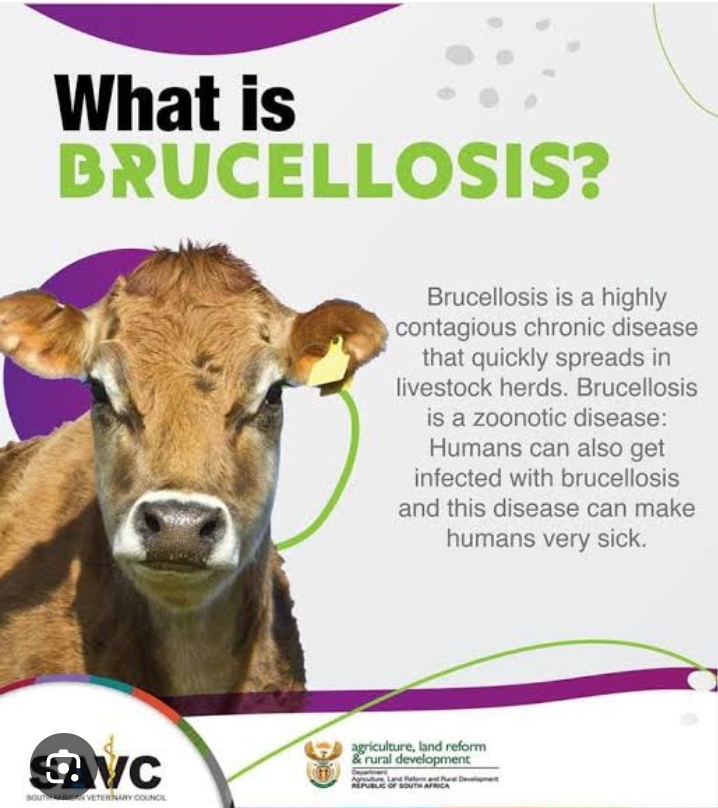
Brucellosis is a Disease that’s Affects Livestocks Mostly in Our Industry:
Brucellosis is a Disease that’s Affects Livestocks Mostly in Our Industry:
Brucellosis is a contagious bacterial disease that primarily affects various animal species, particularly livestock like cattle, goats, sheep, pigs, and sometimes dogs. It is caused by different species of the Brucella bacteria. The disease is characterized by reproductive problems, but it can also cause a range of other health issues in animals. Here’s a detailed look at brucellosis in animals:
Causes:
- Pathogens: The disease is caused by Brucella species, including Brucella abortus (cattle), Brucella melitensis (goats and sheep), Brucella suis (pigs), and Brucella canis (dogs).
- Transmission:
- Direct Contact: Animals can become infected through direct contact with infected animals’ tissues, blood, urine, or other body fluids.
- Ingestion: Consuming contaminated food or water, such as afterbirth or aborted fetuses, can lead to infection.
- Inhalation: In some cases, animals can inhale the bacteria from contaminated dust or aerosols.
- Vertical Transmission: Infected mothers can pass the bacteria to their offspring during birth.

Symptoms in Animals:
- Reproductive Issues:
- Abortion: The most common and significant sign of brucellosis in livestock is abortion, typically during the last trimester of pregnancy.
- Stillbirths: Infected animals may give birth to stillborn offspring.
- Infertility: Infected animals may suffer from infertility or reduced fertility.
- Retained Placenta: Animals may have difficulty expelling the placenta after giving birth, which can lead to further complications.
- Other Symptoms:
- Weak Offspring: Offspring born to infected mothers may be weak or underdeveloped.
- Lameness and Arthritis: In some cases, the bacteria can affect the joints, leading to lameness and arthritis.
- Orchitis: In male animals, brucellosis can cause inflammation of the testicles, leading to swelling and pain.
- Decreased Milk Production: Infected dairy animals may produce less milk.
Diagnosis:
- Serological Tests: Blood tests can detect antibodies against Brucella bacteria.
- Bacterial Culture: Samples from aborted fetuses, placenta, or other tissues can be cultured to identify the presence of the bacteria.
- PCR (Polymerase Chain Reaction): This molecular test can detect Brucella DNA in animal tissues.
Treatment:
- Antibiotics: Treatment with antibiotics in animals is not always effective and can be complicated by the chronic nature of the disease. In many cases, infected animals may be culled to prevent the spread of the disease.
- Management: Supportive care for affected animals, including treatment for secondary infections and inflammation, may be provided.
Prevention and Control:
- Vaccination: Vaccination is one of the most effective ways to control brucellosis in livestock. Different vaccines are available for cattle, goats, and sheep.
- Biosecurity Measures: Implementing strict biosecurity measures, such as controlling animal movement, quarantining new animals, and maintaining good hygiene, can reduce the risk of spreading the disease.
- Testing and Surveillance: Regular testing of livestock and culling of infected animals are crucial for controlling the disease.
- Proper Disposal of Infected Materials: Properly disposing of aborted fetuses, afterbirth, and other potentially infectious materials is essential to prevent the spread of brucellosis.
- Quarantine: Newly introduced animals should be quarantined and tested before being integrated into the herd or flock.
- Also Read about Rabies disease in Animals

Economic Impact:
- Livestock Production: Brucellosis can cause significant economic losses in the livestock industry due to reduced reproductive efficiency, decreased milk production, and the need to cull infected animals.
- Trade Restrictions: Infected herds may be subject to trade restrictions, impacting the ability to sell livestock or livestock products.
Public Health Concern:
Brucellosis in animals is also a public health concern since it can be transmitted to humans (a zoonotic disease). Therefore, controlling brucellosis in animals is crucial for preventing human cases.
Controlling brucellosis in animals requires a comprehensive approach, including vaccination, testing, culling of infected animals, and strict biosecurity measures.
How do the disease affect Animals:
Brucellosis affects animals in various ways, primarily targeting their reproductive systems but also causing general health issues. Here’s how it impacts different aspects of animal health:
1. Reproductive Issues:
- Abortion: The most common effect of brucellosis in animals is abortion, particularly in the later stages of pregnancy. This is especially seen in cattle, goats, and sheep.
- Stillbirths: Infected animals may give birth to stillborn offspring.
- Infertility: Brucellosis can lead to infertility in both male and female animals. In females, the infection can cause long-term damage to the reproductive organs. In males, it can cause orchitis (inflammation of the testicles), which impairs fertility.
- Retained Placenta: Infected females may have difficulty expelling the placenta after giving birth, which can lead to secondary infections and other health complications.
2. Milk Production:
- Decreased Milk Yield: In dairy animals, brucellosis can lead to a significant reduction in milk production. The bacteria can cause inflammation of the udder (mastitis), which further impacts milk quality and quantity.
- Contaminated Milk: Milk from infected animals can contain Brucella bacteria, posing a risk of transmission to humans if consumed unpasteurized.

3. General Health:
- Weight Loss and Weakness: Infected animals often exhibit general signs of illness, including weight loss, lethargy, and reduced appetite. This can lead to poor growth and lower overall productivity.
- Lameness and Joint Issues: In some cases, brucellosis causes inflammation of the joints (arthritis), leading to lameness and pain in affected animals.
- Fever: Animals with brucellosis may experience intermittent fevers, which can contribute to their overall weakness and reduced productivity.
4. Longevity and Productivity:
- Reduced Longevity: Chronic infections can weaken animals over time, making them more susceptible to other diseases and reducing their overall lifespan.
- Lower Productivity: The combination of reproductive issues, decreased milk production, and general weakness leads to lower productivity in infected animals, which can have significant economic implications for farmers.
5. Spread of Disease:
- Transmission to Other Animals: Infected animals can spread the bacteria to others in the herd or flock through contact with bodily fluids, aborted fetuses, or contaminated environments.

Leave a Reply